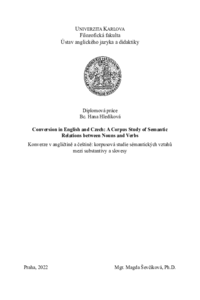Conversion in English and Czech: a corpus study of semantic relations between nouns and verbs
Konverze v angličtině a češtině: korpusová studie sémantických vztahů mezi substantivy a slovesy
diplomová práce (OBHÁJENO)

Zobrazit/
Trvalý odkaz
http://hdl.handle.net/20.500.11956/174483Identifikátory
SIS: 236628
Kolekce
- Kvalifikační práce [24991]
Autor
Vedoucí práce
Oponent práce
Vašků, Kateřina
Fakulta / součást
Filozofická fakulta
Obor
Anglický jazyk - Český jazyk - specializační studium
Katedra / ústav / klinika
Ústav anglického jazyka a didaktiky
Datum obhajoby
30. 5. 2022
Nakladatel
Univerzita Karlova, Filozofická fakultaJazyk
Angličtina
Známka
Výborně
Klíčová slova (česky)
angličtina|čeština|konverze|slovotvorba|sémantický vztahKlíčová slova (anglicky)
English|Czech|conversion|word-formation|semantic relationCílem této diplomové práce je provést korpusově založenou kontrastivní studii sémantických vztahů mezi slovesy a substantivy v konverzních dvojicích v angličtině a češtině. Dvojice sloves a substantiv jako run.v 'běžet/běhat' - run.n 'běh', salt.n 'sůl' - salt.v 'solit' v angličtině a běžet/běhat - běh, sůl - solit v češtině jsou považovány za výsledky slovotvorného procesu nazývaného konverze, ve kterém je vytvořeno nové slovo patřící k odlišnému slovnímu druhu bez použití slovotvorných afixů. S použitím vzorku 300 takovýchto párů v obou jazycích, získaného z Britského národního korpusu pro angličtinu a z korpusu SYN2015 pro češtinu, analyzujeme a klasifikujeme sémantické vztahy mezi slovesy a substantivy. Zaujímáme kognitivní přístup a sémantické vztahy klasifikujeme na základě konceptuálních schémat událostí a jejich složek. Protože substantiva a/nebo slovesa jsou často polysémní, tato sémantická klasifikace také počítá s možností existence více různých sémantických vztahů mezi slovesem a substantivem v jedné konverzní dvojici. V rámci analýzy je zkoumána a porovnána frekvence, se kterou se různé sémantické vztahy objevují v konverzních párech v angličtině a češtině, a také vzorce více různých sémantických vztahů v rámci jednoho konverzního páru. Klíčová slova: angličtina, čeština, konverze,...
The aim of this MA thesis is to carry out a corpus-based contrastive study of the semantic relations between verbs and nouns in conversion pairs in English and Czech. Pairs of verbs and nouns like run.v - run.n, salt.n - salt.v in English and běžet/běhat 'run.v' - běh 'run.n', sůl 'salt.n' - solit 'salt.v' in Czech are taken to be the result of a word-formation process called conversion, in which a new word belonging to a different word class is created without the addition of any derivational affixes. Using a sample of 300 such pairs in both languages, extracted from the British National Corpus for English and from the SYN2015 corpus for Czech, we analyse and classify the different semantic relations existing between the nouns and verbs. We adopt a cognitive approach and classify the semantic relations based on conceptual event schemata and their elements. Because the nouns and/or verbs are often polysemous, the semantic classification also accounts for the possibility of multiple semantic relations existing between the verb and the noun in one conversion pair. In the analysis, we examine and compare the frequencies with which the different semantic relations appear in the conversion pairs in English and Czech, as well as the patterns of multiple semantic relations that appear together in a single...
